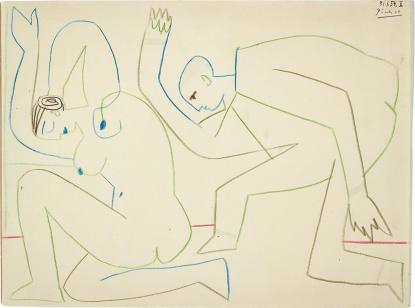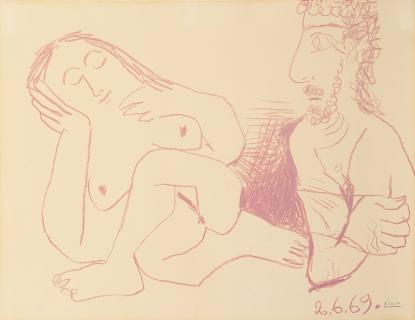Pablo Picasso
Arguably the most famous and influential artist of the 20th century, Pablo Picasso has maintained an unparalleled significance in the story of Modern art. Born in Malaga, Spain in 1881, he began to draw from an early age under the guidance of his father who was an academic painter. After studying at the La Lonja art school in Barcelona, Picasso eventually moved to Paris and established a studio there. After World War II, Picasso moved to the South of France, where he would reside for the rest of his life. He died in Mougins in 1973 at the age of 91.
Painter, draftsman, sculptor, printmaker, photographer, ceramicist, designer, playwright, and poet, Pablo Picasso contributed peerless innovations to the visual culture of the last century. He created several of the great masterpieces of modernism, co-invented collage and Cubism, designed groundbreaking sets and costumes for the theater, coined the term "sur-realism," and invented assembled sculpture (assemblage). Driven by boundless artistic energies and ambitions, he was the very personification of the avant-garde, and many of the movements of the last century could not help but develop in his orbit as artists worked consciously either to absorb his influence or rebel in his shadow. The progression of Picasso's early work is largely categorized by the predominant color scheme employed in his works at any given time. His earliest artistic phase was the Blue Period (1901–04), featuring motifs from everyday Parisian life, and marked with implicit motifs of poverty and loneliness; this was followed by the Rose Period, which introduced more lyrical subjects such as jugglers, acrobats and other performers. Picasso's subsequent transition to Cubism is marked by Les Demoiselles d'Avignon (1907, The Museum of Modern Art, New York), the style that would inflect his work to varying degrees for the rest of his long career. Although Picasso had lived in France for a number of years, the outbreak of the Spanish Civil War had a distinct impact on him. The bombing of the Basque town of Guernica by Franco's government horrified the artist, and moved him to paint the powerful large-scale Guernica, 1937, a poignant anti-war statement first shown at the Spanish pavilion at the Exposition Universelle in Paris (and now in the collection of the Museo Reina Sofia, Madrid). For the remainder of his career, his essential subjects were perception itself, the mysteries of representation, and his own ability to create. Though his work always remained recognizably his own, Picasso could switch tracks and move between styles in a way that might suggest the work of several painters rather than a singular polymath.
Picasso was widely exhibited during his lifetime and continues to be so posthumously. His works are held in the major art collections around the world as well as many museums devoted exclusively to his oeuvre including Musée Picasso, Paris, Museu Picasso, Barcelona, Musée Picasso Antibes, and the Museo Picasso Malaga.

SELECTED WORKS

Pablo Picasso, Deux nus, 1962
Pencil on paper laid on paper
24,1 x 32 cm | 9.5 x 12.6 in

Pablo Picasso, La Répétition, 1954
Coloured pencil and marker on paper
23,8 x 32 cm | 9.4 x 12.6 in

Pablo Picasso, Maternité, 1899
Pastel on paper
47,8 x 40 cm | 18.8 x 15.7 in

Pablo Picasso, Bust of naked man and woman, 1969
Colored wax crayon on paper
50,8 x 65,2 cm | 20 x 25.7 in

Pablo Picasso, Tête de faune barbu, 1946
Watercolour, collage and pencil on paper
65,5 x 50,4 cm | 25.8 x 19.8 in

Pablo Picasso, Le roi carnaval, 1963
India ink and wax crayon on paper
56,2 x 45,7 cm | 21.1 x 18 in